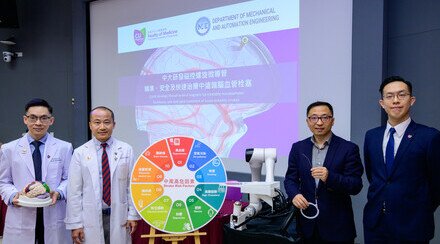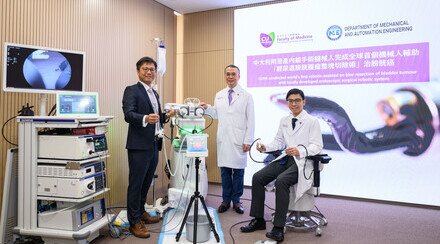CUHK develops a novel magnetic helical microrobot with endoscope-assisted delivery for biofilm eradication in ear tubes

CUHK’s cross disciplinary research team develops a magnetic helical microrobot with endoscope-assisted delivery for biofilm eradication in ear tubes. (From left) Assistant Professor Dr Chang Wai-tsz and Associate Professor Dr Jason Chan from the Department of Otorhinolaryngology, Head and Neck Surgery at CU Medicine; and Professor Zhang Li from the Department of Mechanical and Automation Engineering.
Otitis media is an inflammation or infection located in the middle ear. It is a health problem commonly seen in children, usually caused by upper respiratory infections or bacterial infections. Some patients with fluid build-up, or effusion, need to the undergo the surgical procedure of, inserting a tympanostomy tube (also known as an ear tube or T-tube) in the tympanic membrane to drain the middle ear fluid, alleviating the effusion and pressure in the middle ear. However, bacterial biofilm may form in the ear tube over time and contribute to blockages and recurring infections.
The Chinese University of Hong Kong (CUHK)’s cross disciplinary research team developed a magnetic helical microrobot with endoscope-assisted delivery for biofilm eradication in ear tubes. The novel treatment procedure has been validated in a human cadaver ex vivo, which is a promising sign for clinical application. Study results have been published in the international journal Science Advances.

Featured is the novel system magnetic helical microrobot with endoscope-assisted delivery for biofilm eradication in ear tubes.

A helical microrobot in a tube.
Bacterial biofilms contribute to recurring infections, but eradication is difficult in the tortuous and obstructed auditory canals
About 7% of children under the age of six have had otitis media with effusion. The fluid may resolve on its own within a few weeks but if the condition prevails, surgical treatment becomes necessary. Insertion of an ear tube into the tympanic membrane is a procedure to treat otitis media with effusion. In Hong Kong, it is common for adult or child patients to undergo implant of ear tube for otitis media with effusion.
Biofilm builds up in the ear tube over time and contributes to otorrhea, or drainage of fluid from the ear, and debris deposition, which in turn can cause blockages and recurring infections. For severely blocked ear tubes, surgeons have to use specialised mechanical tools to clear the occlusion or replace the ear tube during endoscopy. This manoeuvre requires delicate expert skills to avoid injuries to the ossicular chain and tympanic membrane.

Dr Chang Wai-tsz says biofilm builds up in the ear tube over time and can cause blockages and recurring infections. For severely blocked ear tubes, surgeons may have to replace the ear tube during endoscopy.
Dr Chang Wai-tsz, Assistant Professor in the Department of Otorhinolaryngology, Head and Neck Surgery at CU Medicine explained, “Recurrent infections of ear refractory to antibiotic treatment and occlusion of the ear tube are the complications related to biofilms after operation. Antibiotics are usually used to prevent biofilm occlusion after surgery, but they cannot prevent infection in the long term, and may lead to antimicrobial resistance. Some patients who suffer from ear tube occlusion require frequent tube replacement, which increases their physical and financial burden.”
Helical microrobots have chemical and mechanical effects in eradicating biofilm
Hence, a research team with members from the Department of Mechanical and Automation Engineering at Faculty of Engineering, and the Department of Otorhinolaryngology, Head and Neck Surgery at CU Medicine joined hands to develop a magnetic helical microrobot with endoscope-assisted delivery for biofilm eradication in ear tube. The treatment system consists of helical microrobot, endoscope, magnetic actuation unit with robotic arm, and catheter. Surgeons first use an endoscope to deliver the helical microrobot with a catheter into the ear tube. Then they can remotely actuate the microrobot by the programmed magnetic field in the ear tube to perform biofilm eradication.

Professor Zhang Li says biofilm has been known for quite sometime. Research team will continue to explore the application of this novel system in other medical devices or implants placed in the human body where biofilm infections can occur.
Professor Zhang Li from the Department of Mechanical and Automation Engineering said, “During my post-doctoral studies at ETH Zurich in Switzerland, I was inspired by the flagellar movement (the locomotion of the tiny hairline appendages found on many plants) to develop helical microrobot. I further investigated the use of magnetic force for better motion control and applied it in the field of medical science. We learned from our counterparts in medicine about the challenge of treating recurrent infections from biofilm formation in ear tubes. From there, we developed helical microrobot that can promote a catalytic reaction to produce diffusion of reactive oxygen species and kill bacteria cells. So the microrobots have both chemical and mechanical methods of eradicating biofilm. The precision movement of the microrobot enables it to perform tasks harmlessly in a confined space with high accuracy, while inducing no pain.”

Dr Jason Chan says the novel treatment procedure has been validated in a human cadaver ex vivo, which is a promising sign for clinical application in five years.
Dr Jason Chan Ying-kuen, Associate Professor in the Department of Otorhinolaryngology, Head and Neck Surgery at CU Medicine said, “The novel treatment procedure has been validated in a human cadaver ex vivo, which is a promising sign for clinical application. The invention can provide a more manageable alternative to the current treatment and alleviate the physical and psychological pressure from repetitive ear tube replacement. Next, we need to acquire more evidence about the safety and stability of the system to promote clinical application.”
Professor Joseph Sung says in a video that this study represents a major breakthrough using both mechanical and chemical methods in the same modalities.
Professor Joseph Sung, Dean of Lee Kong Chian School of Medicine and CUHK’s Emeritus Professor, said, “Although biofilm has been known for quite sometime, the clearance of biofilm has been an unsolved problem for decades. So far, no medication has proven to be useful in clearing the microbes once they are established on the surface as a layer. This study represents a major breakthrough using both mechanical and chemical methods in the same modalities. Its application is not limited to ear tubes for otitis media: potentially it can be used in other medical devices or implants placed in the human body where biofilm infections can occur.”
This study was supported by Research Grants Council, Innovation and Technology Commission, Chow Yuk Ho Technology Centre for Innovative Medicine, CUHK T Stone Robotics Institute, Shenzhen Institutes of Advanced Technology (SIAT) of the Chinese Academy of Sciences (CAS) - CUHK Joint Laboratory of Robotics and Intelligent Systems, and Multi-scale Medical Robotics Center under InnoHK.




















